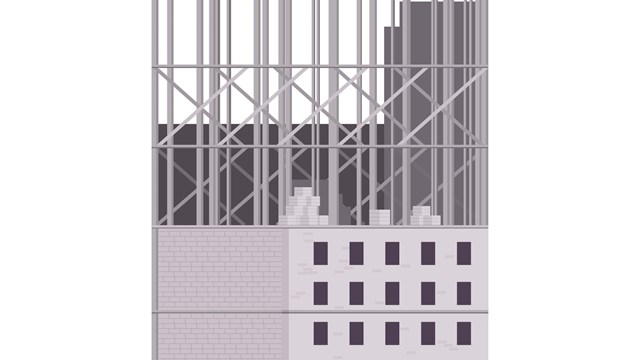The co-op and condo market in New York City has been booming for some time now, so when properties go on sale, it's not very difficult to find a buyer. It doesn't really matter if it's a sprawling penthouse in a hot neighborhood or a small studio on an out-of-the-way street - if it's got four walls and running water (and sometimes even that is negotiable) your unit will sell.
If a seller is to get their asking price and maximize their property's potential, it's important that they do what they can to make the unit as attractive and appealing as possible. But it doesn't stop there. It's not only the unit that people care about - part of what makes an apartment attractive to a prospective buyer is the building itself: its appearance, services, amenities, sense of community, and overall financial and operational stability.
The first thing a prospective buyer will see when they come to view a home is the exterior of a building. Therefore, it's important that boards and managers concentrate on what's on the outside, both with small and major improvements.
"An example of this is the building at 32 Gramercy Park, which had a major change out over the last several years from street to elevator banks to hallways in the buildings," says Douglas Wagner of Benjamin James Associates, a management agency in Manhattan. "Everything was done over to make it look like a much more substantial residence with such an important address."
"On the small scale, a board or manager should do things like make sure awnings look good, and front entrances are clean. Lay down some nice mats, get some planters - make it look like a more homey type of building. There are lots of little things you can do that don't cost that much money," says Karen A. Berman, vice president of Argo Residential, a management firm based in Manhattan. "And if it's a doorman building, the doorman should look very professional. Uniforms are a good start."
Wendy Divack, a broker with Coldwell Banker, agrees. "I think gardening in and around the building is a nice idea. Shrubbery almost always is a good thing. For larger projects, concentrating on the design of brickwork and stonework is important. First impressions are important in the business of selling homes."
"More long-term things might be as basic as re-pointing the brickwork, or as extensive as refinishing the facade of the building," says Wagner. "In the good times that we have had over the last several years, we've been aware of building facades being upgraded and changed out. That's something that would require action by the board, and usually results in an assessment to the shareholders - but a lot of people feel it helps maintain property value."
Sometimes, an overhaul actually increases the property value. Take the infamous "Blue Building" on 65th Street and Madison Avenue, for example. Covered in bright blue tile in the 1920s, it was viewed by many as an eyesore, and was consequently more difficult than most buildings in the area to sell.
ýThat building was horrible," says Jane Bayard of Warburg Realty Partnership. "The only people who didn't mind it were the people who lived in it. They are changing it now and the building is getting hot, where it once was difficult to sell it. There's a building on 72nd Street that also really did a beautiful job on its exterior, putting limestone about a third of the way up the building and really cleaning it up. That's a big dollar item but really it looks just beautiful."
The interior of a building is just as important as the exterior when it comes to attracting buyers. When it comes time to think about this, boards should consider such things as lighting, carpets, or lobby space. These items all make the building's units more sellable.
"If the lobby looks shabby when people first walk in, fix it up. The hallways need to look good, and even the ceilings should be cleaned regularly," says Berman. "Mirrors should be shiny, and there should be bright, proper lighting. Elevators should look good. If the halls and lobby are carpeted, make sure the carpet or rugs are vacuumed by the staff daily."
Bayard agrees, "If a building has ugly glass doors, changing to wood doors at building entrances can really help," says Bayard. "Putting up artwork or fresh flowers in the lobby is also good. People are very impressed when they enter a building and it's obviously had some care put into its appearance. Your public spaces shouldn't look shabby - put the decorating committee to work."
Although there are plenty of substantial, big-ticket changes that can be made as well - such as gutting lobbies and changing elevators - it's not always necessary to make major improvements to positively influence the value of the apartments in a building.
For an example, says Wagner, "Look at 101 West 23rd Street. That's a co-op where they simply installed some new sheetrock, laid out the lobby a little differently, painted it wild colors and put down a different floor and it looks like a new building. This is an apartment building where the co-ops don't necessarily have the highest value in the area, but they've improved the presentation substantially."
A well-considered change in the design of an exterior or interior is almost always an improvement, but there are some common layout mistakes that buildings can make that can inadvertently affect a buyer's opinion of a building.
"It's a mistake to take utility functions and doll them up to the point where they look really great but are not as useful as they were previously," says Wagner. "I've seen people put in really fancy, ornate paneling into elevators that makes the elevator difficult to fit people in or bring things up. These days, the bigger the elevator cabs the better."
For buildings that decide to spend a lot of money to make the lobby larger, this could have consequences as well. "Sometimes people shy away from very large lobbies," says Divack. "People may be more likely to hang out in the lobby, and that is not always appropriate."
Of course, all the cosmetic fluffing in the world won't help if your building is in the red financially. When it comes to reserve funds, all buildings take a different position on how much money should be carried in the reserve. Some want three times the maintenance, some suggest matching the residents' monthly maintenance, and others prefer a certain fixed baseline amount in the coffers at all times.
The building's specific policy is something a buyer will consider when looking at prospective apartments, says Wagner, but generally, "The healthier the reserve fund, the more likely the building's financials are strong. That's important for a purchaser to know."
"A lot of purchasers will come to sale asking what the monthly will be," agrees Bayard. "A high monthly maintenance charge would be the biggest turnoff for people because it reduces their borrowing power. Compared to that, I'm not sure how important a reserve fund is for buyers.
There are some other gaffes - some avoidable, and some less so - that can affect a building's saleability in the eyes of a prospective resident. If major construction projects are underway when someone is starting to look at the building, that could be a major turnoff.
"If our agents are showing an apartment in a building where there is major work underway, the first red flag is, "˜What's this going to cost in the short run?'" says Wagner. "The buyers want to know how much the assessment that's planned to pay for all of this work is going to be. There are very few buildings that will just grab all that money out of the reserve funds. Those expenses get passed along - and those details should be disclosed at the showing of the premises, though they're not always."
Any attorney doing their due diligence prior to letting their client buy a co-op should ask how capital improvement work will impact new residents, and how the tab for the work will be settled.
"The attorney should check all that out," says Divack. "If you know something, you have to disclose it. They should review minutes of board meetings and determine the details of any major assessment."
Although many buildings don't have the space for them, adding a health spa or gym is often a great means of attracting buyers to a building.
"Not everyone is looking for a gym," says Divack, "but it certainly enhances things these days."
It's also important to consider whether your building would benefit more from a run-of-the-mill in-house gym, or from something more diversified; a so-called "lifestyle center."
According to Terri Wiezycki, vice president of business development for American Leisure Corporation, a design and management company specializing in developing residential fitness facilities, the difference between a gym and a lifestyle center is a question of usage and degree.
"Whereas a gym or fitness center offers people a facility in which to work out with cardio equipment, Nautilus-type circuit training equipment, and old-fashioned free weights, a lifestyle center includes all sorts of additional amenities and goes well beyond just fitness. Some centers are more like spas," says Wiezycki, "offering massage therapy, yoga classes, and nutritional consulting, while still others feature darkrooms, children's playrooms, and even business centers."
Because so many new developments are offering health centers and gyms, adding some thoughtful extras to your building's fitness center can help attract younger families to an older building. Amenities like playrooms for children and entertainment rooms where people in the building can have parties outside of their apartments are also big draws - provided you can find a place to put them.
"With older buildings it's all about finding spaces that were used for other purposes - like servants' quarters or old coal storage areas in the basement - to do these things," says Bayard. " It makes a big difference and it's getting very competitive. If those amenities aren't there, it can cast a shadow on the building."
According to Mercedes Menocal-Gregoire, a long-time broker with Stribling & Associates, a Manhattan-based brokerage that specializes in luxury properties, another option is to bring in a concierge service.
"If you buy something in the north tower of the Time Warner building at Columbus Circle," says Menocal-Gregoire, "you're part of The Mandarin Hotel. You can pay an extra fee and get the same hotel services as guests at the Mandarin: maid service, three times a day, room service from all the restaurants in Time Warner Center, access to the spa and the pool in the hotel. You have full concierge service. They'll make reservations for you to go to the moon if you have to."
Of course, not everybody lives at the Mandarin, and even a well-funded building has to watch the bottom line. But bringing in a concierge service and working out ways to make shareholders' lives a little easier is another way to build value for shareholders and position your building as successfully as possible. These are just some of the things that managers and boards should consider when trying to get new buyers into their building. It's always important to keep an eye on the look of the building and do what you can to upgrade and keep it looking nice.
"The biggest problem," says Berman, "is when a board isn't spending the money. You need to spend money to make money. You have to maintain the building and services."






Leave a Comment